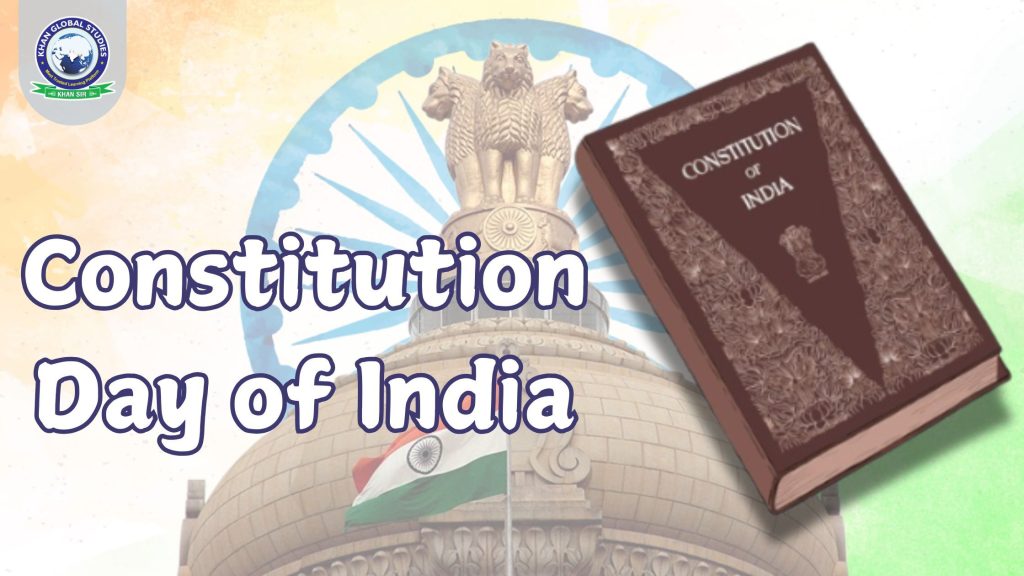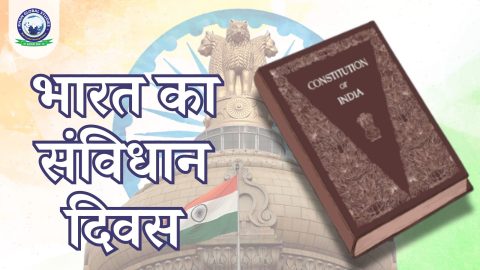Constitution Day of India, also known as “Samvidhan Diwas” and “National Law Day”, is celebrated every year on November 26. The day commemorates the adoption of the Indian Constitution in 1949 when it was approved by the Constituent Assembly. It came into force on January 26, 1950, making India a sovereign, democratic republic.
Constitution of India
Preamble
WE, THE PEOPLE OF INDIA, having solemnly resolved to constitute India into a 1(SOVEREIGN SOCIALIST SECULAR DEMOCRATIC REPUBLIC) and to secure to all its citizens:
JUSTICE, social, economic and political;
LIBERTY of thought, expression, belief, faith and worship;
EQUALITY of status and of opportunity;
and to promote among them all
FRATERNITY assuring the dignity of the individual and the 2(UNITY AND INTEGRITY OF THE NATION);
IN OUR CONSTITUENT ASSEMBLY this twenty-sixth day of November, 1949, do HEREBY ADOPT, ENACT AND GIVE TO OURSELVES THIS CONSTITUTION.
______________________________________________________________
1. Substituted by the Constitution (Forty-second Amendment) Act, 1976, section 2 (w.e.f. 3.1.1977) for “sovereign democratic republic”.
2. Substituted by the Constitution (Forty-second Amendment) Act, 1976, section 2 (w.e.f. 3.1.1977) for “unity of the nation”.
______________________________________________________________
Constitution of India: Introduction and Background
- Constitution of India: The Supreme Document
The Constitution of India is the supreme legal document of the country. It defines the basic political code of governance, structure, procedures, powers and duties of government institutions. It also sets forth the fundamental rights, directive principles and duties of citizens. This is the longest-written constitution in the world.
- constitutional supremacy
The Constitution provides for constitutional supremacy in India, not parliamentary supremacy. It was made by the Constituent Assembly, not by Parliament. Parliament cannot overturn the Constitution. The Constitution is declared in its Preamble and has been adopted by the people of India.
- Adoption and effective date
The Constitution was adopted by the Constituent Assembly on 26 November 1949 and came into force on 26 January 1950. It replaced the Government of India Act 1935 and transformed India from a British Dominion into an independent democratic republic. Under Article 395, the Constitution superseded the former laws of the British Parliament.
- Declaration of India as a Republic
The Constitution declared India a sovereign, socialist, secular and democratic republic. It ensures justice, equality, liberty and fraternity. India as a republic celebrates Constitution Day on 26 January.
- Protection of the Constitution
The original 1950 Constitution is preserved in a nitrogen-filled chamber in the Old Parliament House in Delhi.
History
- Nehru Report and Initial Attempts: In 1928, the All Parties Conference submitted the Nehru Report to draft the Constitution of India in Lucknow.
- British Rule and Process of Independence: From 1858 to 1947, India was under British rule. Between 1947 and 1950, India remained a British Dominion, where Sardar Vallabhbhai Patel and V.P. Menon ensured the integration of various princely states.
- Independence and Effect of Constitution: The Constitution of India came into effect on 26 January 1950, repealing the Indian Independence Act 1947 and the Government of India Act 1935. With this, India became an independent republic from a Dominion of the British Crown.
- Articles of the Constitution coming into effect: Some Articles of the Constitution (5, 6, 7, 8, 9, 60, 324, 366, 367, 379-394) came into force on 26 November 1949, while the remaining articles came into force on 26 January 1950.
Constitution Making
- B. N. Rau, who became the constitutional advisor to the Constituent Assembly in 1946, prepared the initial draft of the Constitution in February 1948. This draft contained 243 articles and 13 schedules, which after amendments turned into 395 articles and 8 schedules.
- A 7-member drafting committee was formed on 29 August 1947 to discuss the draft, headed by Dr. B. R. Ambedkar. This committee presented the revised draft on 4 November 1947.
- The Constitution was adopted on 26 November 1949 and 284 members signed it. In the last session on 24 January 1950, all the members signed two copies. The handwritten original copy of the Constitution was decorated by artists of Shantiniketan.
- The Constitution came into force from 26 January 1950 and is celebrated as National Law Day. So far more than 100 amendments have been made in it.
Indian Constitution: A wonderful document
- Drafting Committee and its hard work:
A drafting committee was formed to prepare the Indian Constitution, which was headed by Dr. Bhimrao Ambedkar. This committee deliberated for 2 years, 11 months and 18 days and finally drafted the Constitution.
- Long and Detailed Constitution:
It is the longest-written constitution in the world. When it was adopted, it had 395 articles and 8 schedules. Later, many amendments were made to it.
- Features of the Constitution:
The Indian Constitution is both rigid and flexible. It is inspired by the constitutions of various countries but takes into account the diversity and needs of India.
Timeline of the making of the Indian Constitution
- 6 December 1946: The Constituent Assembly was formed (according to the French system).
- 9 December 1946: The first meeting of the Constituent Assembly was held in the Constitution Hall (presently the Central Hall of Parliament House). The meeting was addressed by J.B. Kripalani and Sachchidanand Sinha became the temporary President. The Muslim League boycotted the meeting demanding a separate state.
- 11 December 1946: Rajendra Prasad was elected the President of the Constituent Assembly. H.C. Mukherjee became the Vice-President and B.N. Rau was appointed Constitutional Legal Adviser. Initially, the Assembly had a total of 389 members, which was reduced to 299 after the partition. Of these, 292 members were from the provinces, four from the Chief Commissioner Provinces and 93 from the princely states.
- 13 December 1946: Jawaharlal Nehru presented the “Objective Resolution”, which mentioned the fundamental principles of the Constitution. It later became the Preamble of the Constitution.
- 22 January 1947: The Objective Resolution was passed unanimously.
- 22 July 1947: The national flag was adopted.
- 15 August 1947: India became independent and was divided into two dominions—India and Pakistan.
- 29 August 1947: The Drafting Committee was formed, with B.R. Ambedkar as its chairman. The other six members of the committee were: K.M. Munshi, Muhammad Saadulla, Alladi Krishnaswamy Ayyar, N. Gopalaswami Ayyangar, Devi Prasad Khaitan and B.L. Mitter.
- 16 July 1948: V.T. Krishnamachari was elected the second vice-president of the Constituent Assembly along with Harendra Kumar Mukherjee.
- 26 November 1949: The Constituent Assembly passed and adopted the Constitution of India.
- 24 January 1950: The Constituent Assembly held its final meeting. The Constitution was signed and ratified. It contained 395 articles, 8 schedules and 22 parts.
- 26 January 1950: Indian Constitution came into force. The process took 2 years, 11 months and 18 days to complete, costing a total of ₹6.4 million.
- After becoming a Republic: G.V. Mavalankar became the first speaker of the Lok Sabha (lower house of Parliament).
Creation and Sources of the Constitution
- Inspiration from Previous Legislatures: The Constitution of India was drawn from several sources. These include the Government of India Act of 1858, the Indian Councils Acts of 1861, 1892 and 1909, the Government of India Acts of 1919 and 1935, and the Indian Independence Act of 1947.
- Partition and New Legislatures: Under the Indian Independence Act of 1947, two separate Constituent Assemblies were formed for India and Pakistan. Each new assembly was given the power to independently frame and enact its constitution.
Objectives of the Constitution
- Justice: Social, economic and political justice.
- Liberty: Freedom of thought, expression, belief and worship.
- Equality: Equality of opportunity and status for all citizens.
- Fraternity: An effort to ensure the dignity of the individual and the unity of the nation.
Declaration of Constitution Day
The Government of India declared 26 November as Constitution Day by issuing a notification on 19 November 2015. Earlier, the day was celebrated as “Law Day”. Prime Minister Narendra Modi announced while laying the foundation stone of B. R. Ambedkar’s “Statue of Equality” memorial in Mumbai on 11 October 2015.
Constitution Day in 2021 also marks the 131st birth anniversary of Dr. Bhimrao Ambedkar. Ambedkar, who was the chairman of the drafting committee of the Constituent Assembly, played a key role in drafting the Indian Constitution. The day was chosen to publicise Ambedkar’s ideas and his contributions.
Importance of Constitution Day
Constitution Day is a celebration of values such as justice, liberty, equality and fraternity, which are enshrined in the Constitution. The day is celebrated to honour the contribution of Dr. Bhimrao Ambedkar, the chief architect of the Indian Constitution, and to raise awareness of the rights and duties of citizens.
Officially declared in 2015, the day reminds us of the uniqueness of the Constitution and its role in laying the foundation for building a progressive and inclusive India.
Why is Constitution Day celebrated?
- Honouring Dr. Ambedkar: Dr. Ambedkar is considered the chief architect of the Constitution. Constitution Day is an occasion to honour his ideas and contributions.
- National Integration and Inclusiveness: This day inspires us to embrace the values enshrined in the Constitution and understand the rights and duties of citizens for the development of the country.
- India’s Democratic Journey: This day is an occasion to remember a historic step towards India’s democratic transformation.
Special Achievements
In 2023, the Government of Manipur released a bilingual version of the Indian Constitution in the Meitei language (Meitei Mayek script) and English on the occasion of Constitution Day. This is the first time the Constitution has been published in this language. This version was made available in all educational institutions, government offices and public libraries in Manipur.
Conclusion
Constitution Day is not just a date, it symbolizes the soul of Indian democracy and our national values. This day reminds us that our Constitution is a document of not just rights but also duties. It is an occasion when we take pride in our achievements as a nation and reaffirm our commitment to the future.
Frequently Asked Questions
Q: When and why is Constitution Day celebrated?
Ans: Constitution Day is celebrated every year on 26 November. This day is celebrated to commemorate the adoption of the Indian Constitution in 1949. It is celebrated to honour the contribution of Dr. Bhimrao Ambedkar and to make citizens aware of the Constitution.
Q: What is the importance of the Preamble of the Indian Constitution?
Ans: The Preamble of the Indian Constitution is the essence of the Constitution. It defines fundamental principles such as justice, liberty, equality and fraternity and is considered the soul of the Constitution.
Q: How long did it take to draft the Indian Constitution and who led it?
Ans: It took 2 years, 11 months and 18 days to draft the Indian Constitution. The chairman of its drafting committee was Dr. Bhimrao Ambedkar.
Q: Why is the Indian Constitution special in the world?
Ans: The Indian Constitution is the longest-written constitution in the world. It is a wonderful blend of rigidity and flexibility and has been designed keeping in mind the diversity of India.
Q: What activities are organised on Constitution Day?
Ans: Preamble recitation, essay competitions, quizzes and mock parliamentary debates are organised in schools and colleges on Constitution Day. Indian embassies and schools also celebrate it.
Q: When were the words “socialist” and “secular” added to the Indian Constitution?
Ans: The words “socialist” and “secular” were added to the Indian Constitution through the 42nd Constitutional Amendment (1976).




